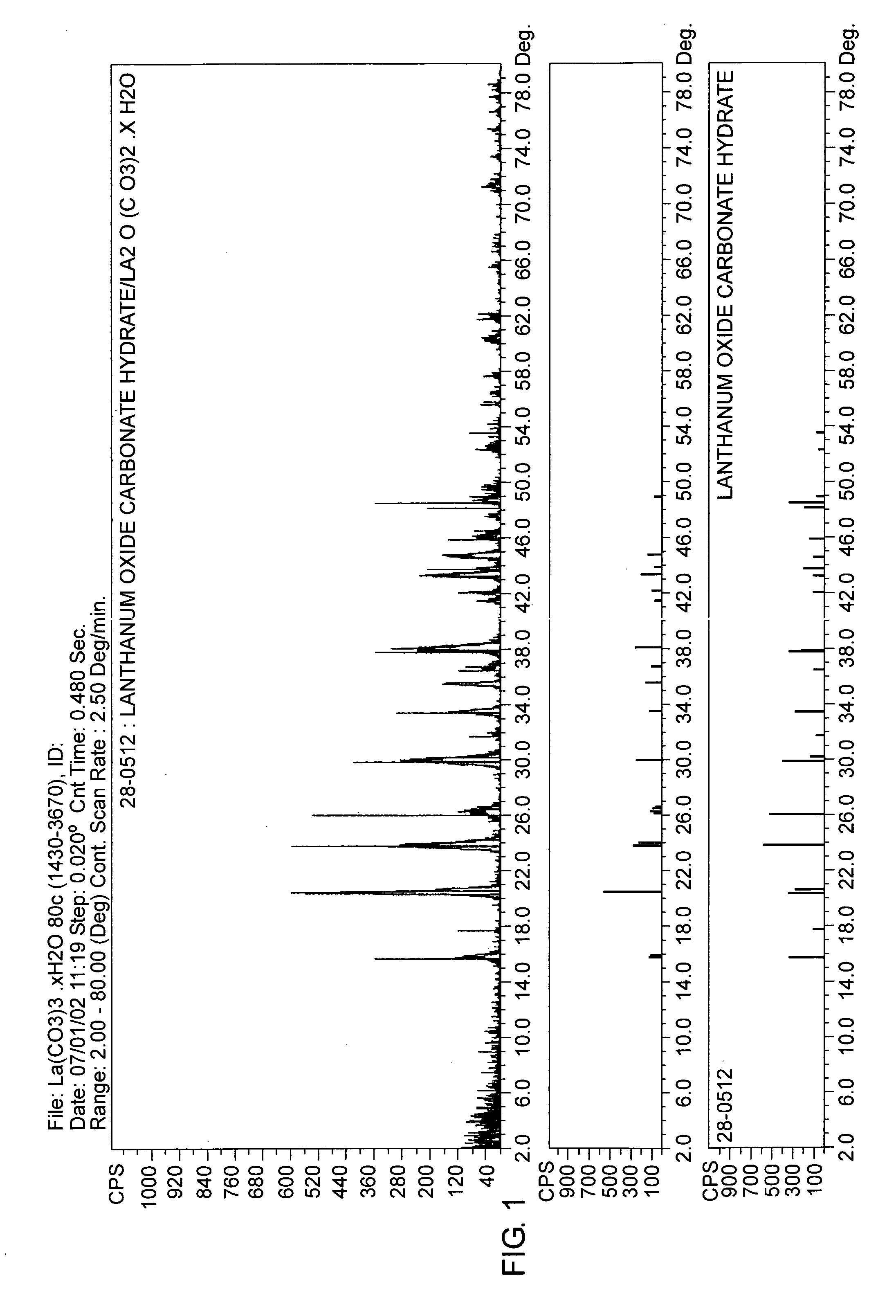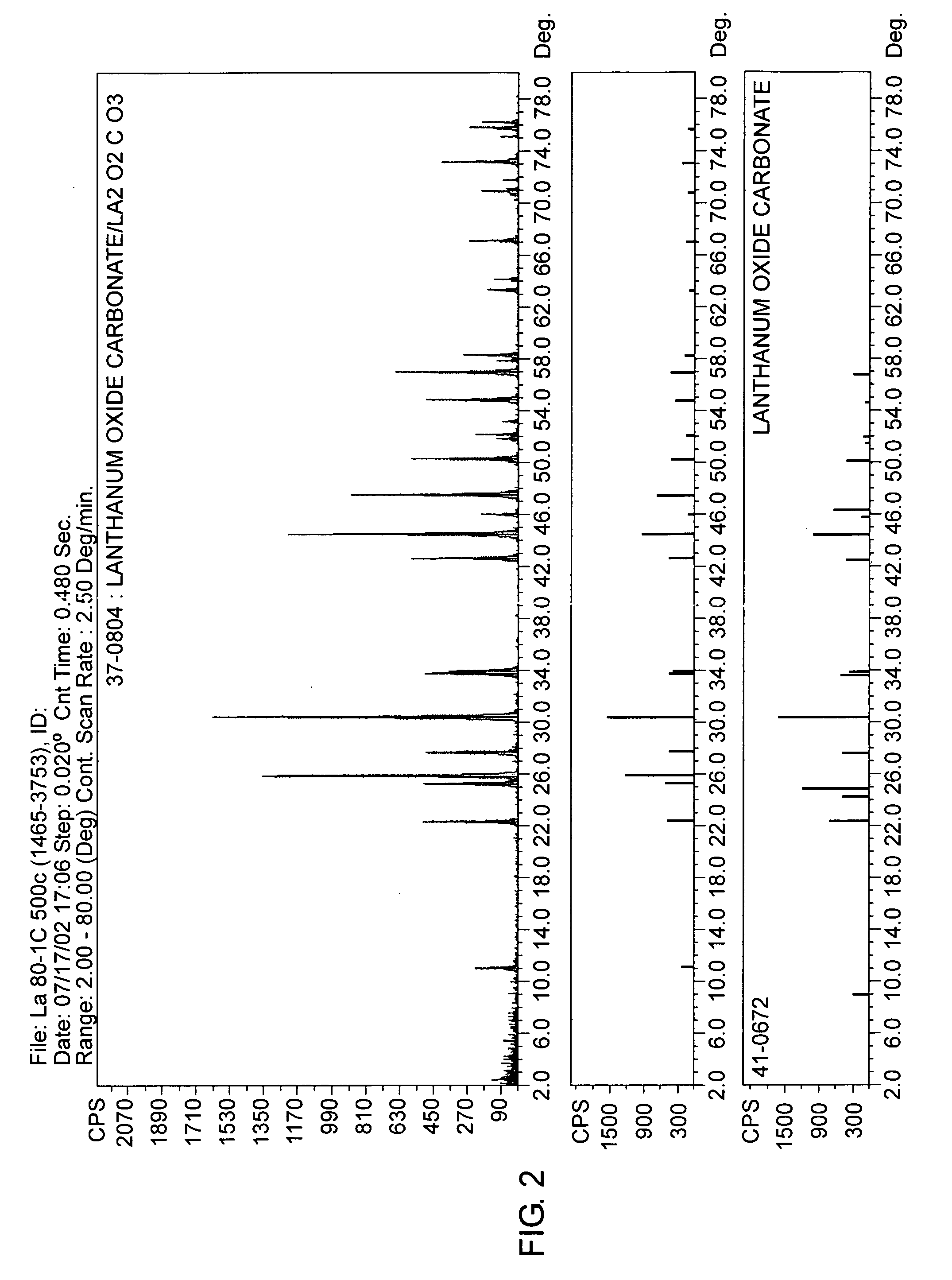Phosphate binder with reduced pill burden
a phosphate binder and pill technology, applied in the field of compositions and formulations, can solve the problems of increased dialysis mortality, renal osteodystrophy, increased concentration of toxins and salts in the blood,
- Summary
- Abstract
- Description
- Claims
- Application Information
AI Technical Summary
Benefits of technology
Problems solved by technology
Method used
Image
Examples
example 1
[0049] An aqueous HCl solution having a volume of 334.75 ml and containing LaCl3 (lanthanum chloride) at a concentration of 29.2 wt % as La2O3 was added to a four liter beaker and heated to 80° C. with stirring. The initial pH of the LaCl3 solution was 2.2. Two hundred and sixty five ml of an aqueous solution containing 63.59 g of sodium carbonate (Na2CO3) was metered into the heated beaker using a small pump at a steady flow rate for 2 hours. Using a Buchner filtering apparatus fitted with filter paper, the filtrate was separated from the white powder product. The filter cake was mixed four times with 2 liters of distilled water and filtered to wash away the NaCl formed during the reaction. The washed filter cake was placed into a convection oven set at 105° C. for 2 hours, or until a stable weight was observed. The product consists of lanthanum carbonate hydroxide, LaCO3OH. FIG. 1 shows an X-ray diffraction scan of the compound as compared to a reference sample.
[0050] To determin...
example 2
[0051] An aqueous HCl solution having a volume of 334.75 ml and containing LaCl3 (lanthanum chloride) at a concentration of 29.2 wt % as La2O3 was added to a 4 liter beaker and heated to 80° C. with stirring. The initial pH of the LaCl3 solution was 2.2. Two hundred and sixty five ml of an aqueous solution containing 63.59 g of sodium carbonate (Na2CO3) was metered into the heated beaker using a small pump at a steady flow rate for 2 hours. Using a Buchner filtering apparatus fitted with filter paper the filtrate was separated from the white powder product. The filter cake was mixed four times with 2 liters of distilled water and filtered to wash away the NaCl formed during the reaction. The washed filter cake was placed into a convection oven set at 105° C. for 2 hours until a stable weight was observed. Finally, the lanthanum oxycarbonate was placed in an alumina tray in a muffle furnace. The furnace temperature was ramped to 500° C. and held at that temperature for 3 hours. The r...
example 3
[0054] A solution containing 100 g / l of La as lanthanum acetate is injected in a spray-drier with an outlet temperature of 250° C. The intermediate product corresponding to the spray-drying step is recovered in a bag filter. This intermediate product is calcined at 600° C. for 4 hours. X-Ray diffraction of the product showed that it consists of anhydrous lanthanum oxycarbonate. The formula for this compound is written as (La2CO5).
[0055] To determine the reactivity of the lanthanum compound with respect to phosphate, the following test was conducted. A stock solution containing 13.75 g / l of anhydrous Na2HPO4 and 8.5 g / l of HCl was prepared. The stock solution was adjusted to pH 3 by the addition of concentrated HCl. An amount of 100 ml of the stock solution was placed in a beaker with a stirring bar. La2CO5 powder, made as described above, was added to the solution. The amount of lanthanum oxycarbonate was such that the amount of La in suspension was 3 times the stoichiometric amoun...
PUM
| Property | Measurement | Unit |
|---|---|---|
| Volume | aaaaa | aaaaa |
| Pressure | aaaaa | aaaaa |
Abstract
Description
Claims
Application Information
 Login to View More
Login to View More - R&D
- Intellectual Property
- Life Sciences
- Materials
- Tech Scout
- Unparalleled Data Quality
- Higher Quality Content
- 60% Fewer Hallucinations
Browse by: Latest US Patents, China's latest patents, Technical Efficacy Thesaurus, Application Domain, Technology Topic, Popular Technical Reports.
© 2025 PatSnap. All rights reserved.Legal|Privacy policy|Modern Slavery Act Transparency Statement|Sitemap|About US| Contact US: help@patsnap.com


